Project Spotlight: PLA Pump to Plug by Spiegel Aihara Workshop
Electric vehicles are becoming increasingly efficient, available, and desirable, a development that helps solve a colossal and increasingly urgent task in the climate crisis: reducing greenhouse gas emissions and global reliance on oil. But as EV continues to proliferate, existing infrastructure needs to evolve and transform with it. One of the largest issues remains providing enough charging stations for the influx of EV, while remediating and repurposing increasingly obsolete gas stations in the process. This is especially true in states like California, which has committed to stop selling new gas-powered cars by 2035.
Enter Pump to Plug: a symposium commissioned in 2020 by the City of LA that invited six offices of architects, urban planners, and landscape architects from around the world to envision a future where EV charging stations are available to everyone, across the city—not just those with standalone homes and private driveways. Here, we explore Spiegel Aihara Workshop’s proposed solution: PLA, a network of reconfigurable, re-deployable charging stations built from an electrified kit of parts. Its goal: to simultaneously make rapid vehicle charging more accessible, activate underutilized urban sites, and repurpose gas stations for public good.
Below, SAW co-founders Dan Spiegel and Megumi Aihara answer our burning questions on the intersection of EV infrastructure, public space, and planned obsolescence.
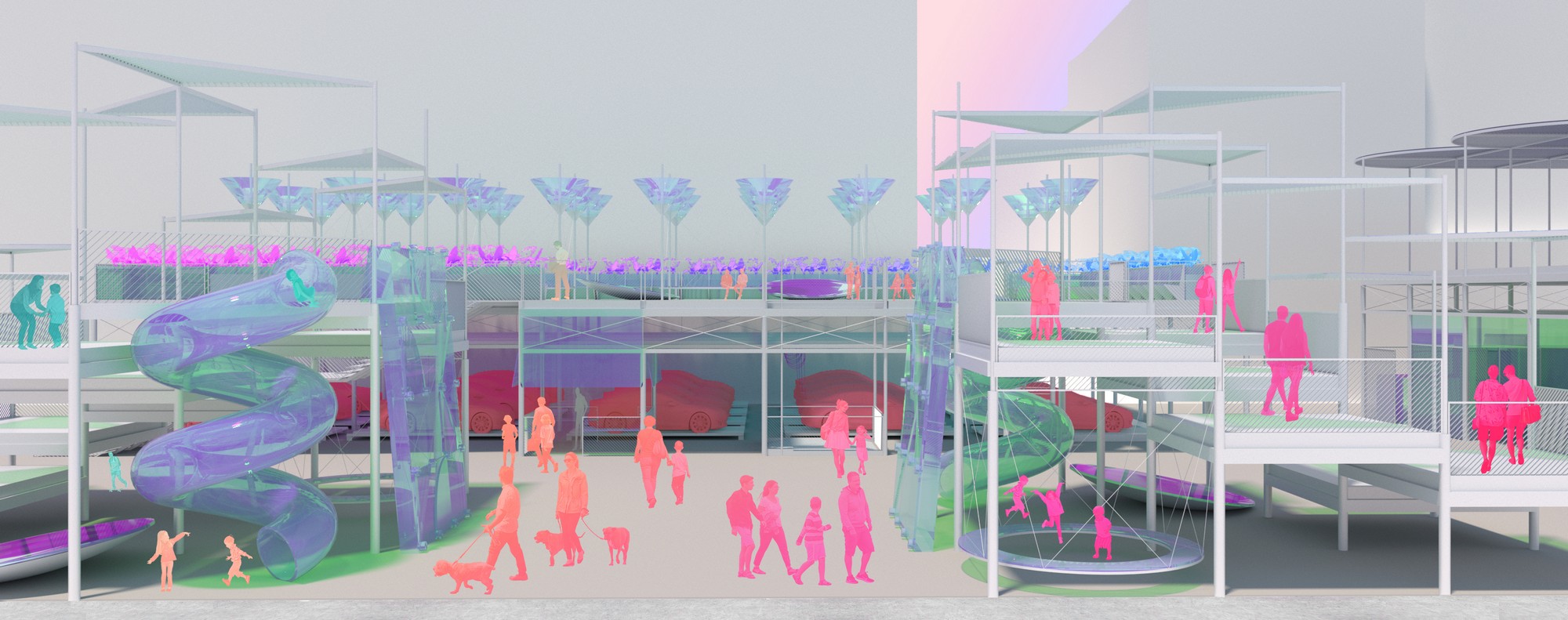
Q&A: EV Infrastructure and Public Space
All new passenger vehicles sold in California must be zero-emissions by 2035, but charging infrastructure is lacking. Most EV owners are single-family homeowners; the average urban renter doesn’t have access to charging at home. As architects and landscape architects, what do you think needs to happen to meet this goal?
Dan Spiegel: We’re at a critical moment in the development of EV’s. The good news is that in contrast to previous iterations, EV’s are now broadly efficient, increasingly affordable, and desirable. Given that access to charging infrastructure is limited, and charging currently takes at least 6 times longer than fueling, the basic spatial math just doesn’t allow a simple transition from gas stations to charging stations. On the other hand, it’s much easier, cleaner, safer, and quieter, to supply electricity than gasoline. Eventually, this means that the charging infrastructure will need to become more diffuse: imagine that every parking space with a parking meter could also be a charging station.
“Ultimately, EV charging is a puzzle of time, space, and experience—almost definitionally a task for the intersection of architecture and landscape.”
Ultimately, EV charging is a puzzle of time, space, and experience—almost definitionally a task for the intersection of architecture and landscape. It’s a two-fold challenge: we need to produce places for charging, but also produce places for people during charging. What are the kind of activities that we willingly park for, and how can we further accommodate them? We’ve specifically envisioned several scenarios: a park, a playground, a cafe, a docking workstation, a cafe, a restaurant, an event space, a movie theater, a basketball court, and others. Different neighborhoods will require different solutions at different points in time. The key is to make vehicle charging feel like the byproduct of some more natural, intentional, desirable activity—and then to design a spatial infrastructure that can accommodate both simultaneously.
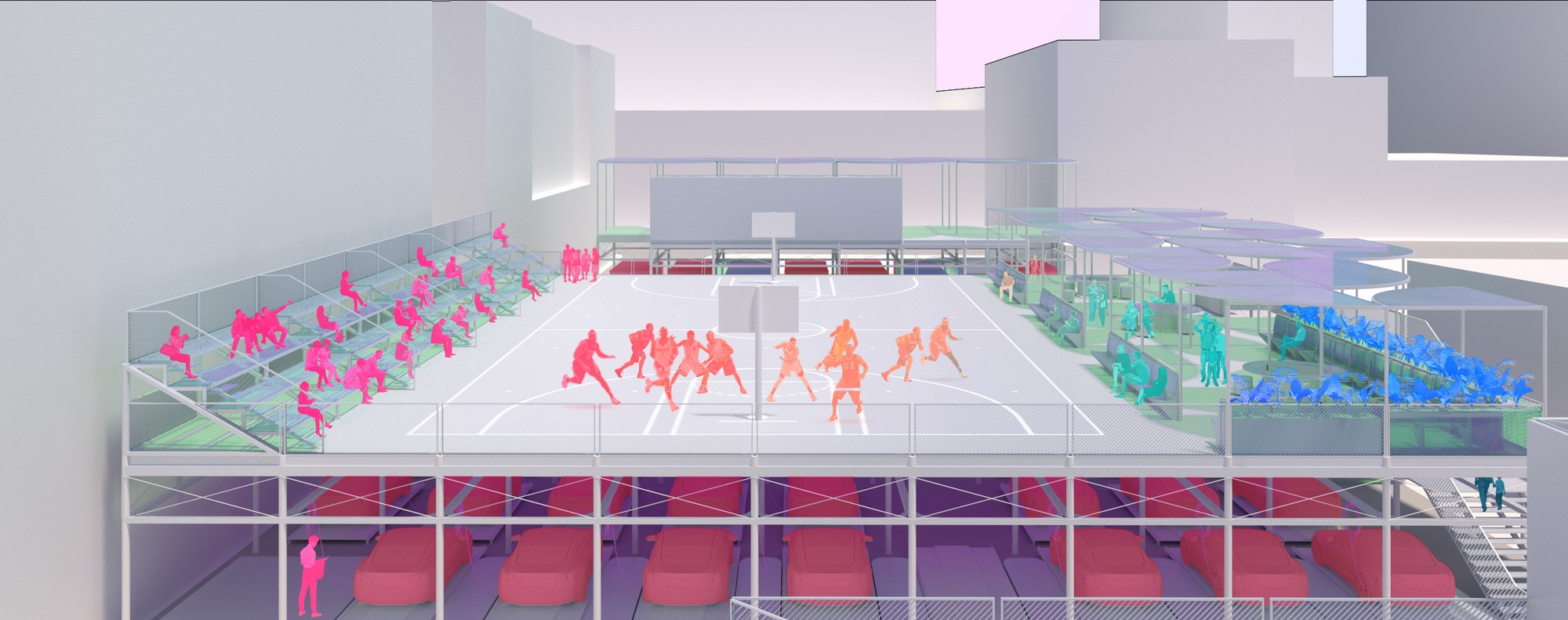
Given how quickly technology changes and advances, how are you thinking about “planned obsolescence” in relation to EV in general and this project in particular?
DS: The ultimate goal here is an EV charging infrastructure that is so ubiquitous, dispersed, and efficient that the idea of a “station” or even a “hub” is totally obsolete. In the meantime, temporary charging stations will play a critical role to bridge the gap.
Megumi Aihara: The question then becomes, what do we do with our existing gas station sites, which are essentially dirty sites in need of remediation. Even if we can’t immediately turn these parcels into parks, we could phase in strategies to green them up—maybe filling them with boxed trees and benches, for one—to re-introduce the idea of rest and shade and restorative green in a place where it previously did not exist.
DS: Most gas stations also occupy critical locations (usually corners) on urban blocks, meaning that it’s not sufficient to just fill them with something new. There needs to be a coherent urban planning strategy in order to fulfill and augment the non-fueling services of gas stations. Planning for obsolescence is one thing, but it’s pretty irresponsible to not plan for the subsequent reemergence.
We looked at 26 of these sites (a nod to Ed Ruscha’s “26 Gas Stations”) and developed a range of remediation strategy types: Service, Preserve, Fill, and Prototype. These all share a common process to deploy EV and social infrastructure: move the kit around the site to allow for simultaneous activation and remediation, and gradually draw down the PLA deployment as final redevelopment is completed. We think of these deployments less as temporary and more as transitional. It’s a redevelopment strategy with the positive outcome of providing EV charging infrastructure and continuous site activation in the interim. In some cases this will be housing, in some cases a park, in others retail space—but they are bound by an electrification process.
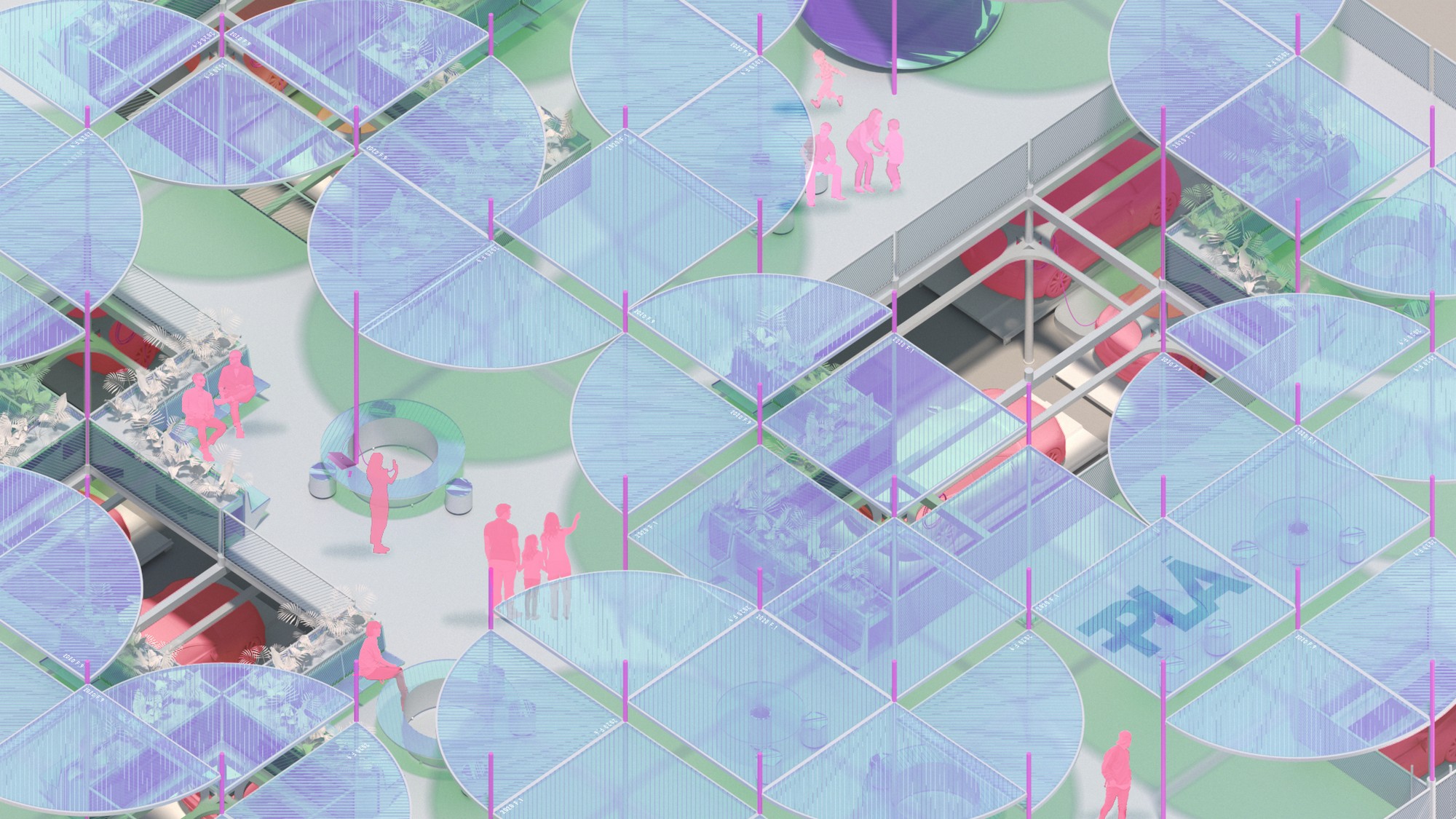
Your proposal for “Pump to Plug” draws from traditions of scaffolding, set design, and event space. Can you talk about how your vision for EV charging stations, which are modular, temporary, and re-deployable, fits into a zero-emissions future?
DS: A scaffold is not just a tectonic system, but really a diagram for what we think the role of PLA should be. It’s still a temporary structure, but rather than assisting in the assembly of a building, it is assisting in the assembly of an infrastructure. It is real, material, and inhabitable—but it’s job is to work so well that it can go away. Were also making a clear reference to the design of the 1984 Los Angeles Olympics (Sussman, Prejza, Jerde) which deployed a graphics-heavy, structure-light kit of parts to exuberantly mark the games throughout the city. It was amazing how much place making could be done with so little architecture, which is wholly appropriate for a temporary event—and in our case, a temporary infrastructure.
Designing for a temporary structure is key, but it doesn’t do nearly as much good if they produce excessive waste or lose all utility after deployment. In this case, ease of disassembly and redeployment is just as important as ease of installation. It’s infeasible and undesirable to replace all of the gas stations at once—we need to provide a grace period for broad adoption—which means these same kits (in different configurations) can be redeployed from station to station, minimizing waste of material resources.
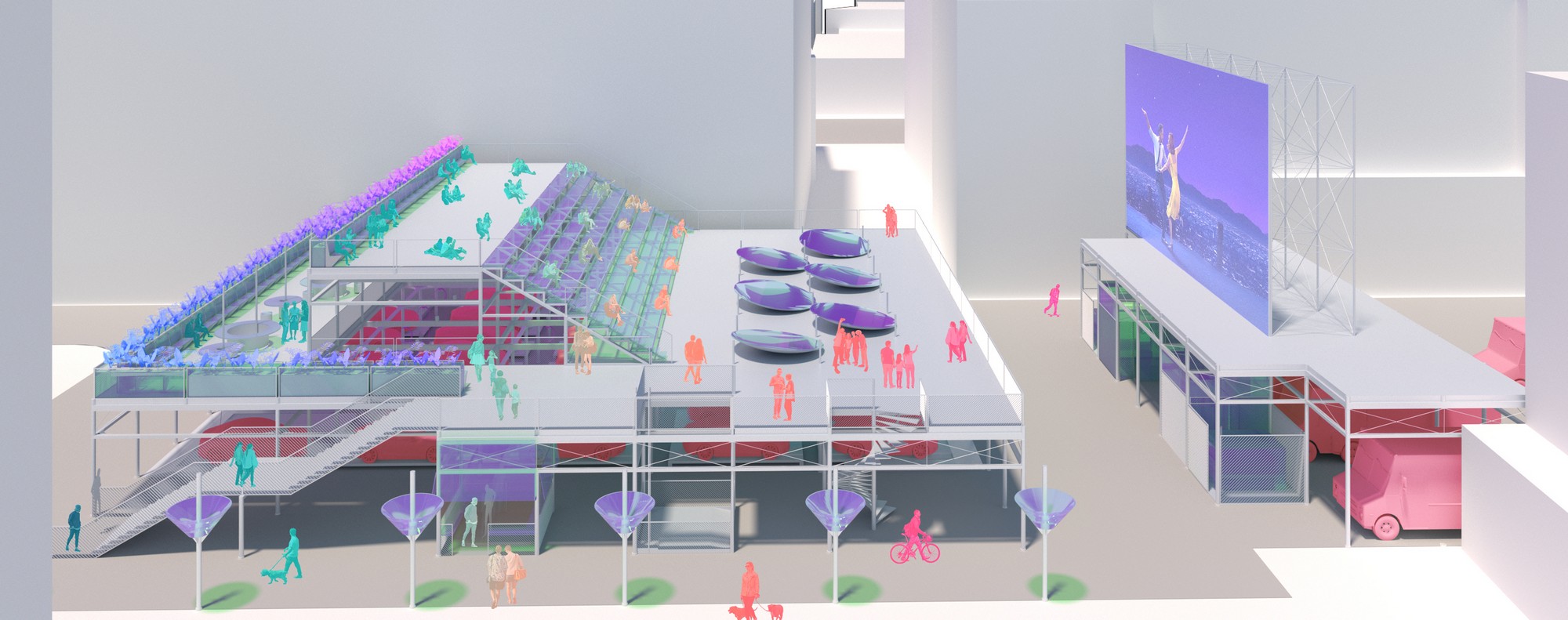
What is the importance or impact of designing EV charging as part of a landscape of leisure and/or everyday urban amenities? How can thoughtful landscape design, more generally, aid in making the transition from gas stations and gas-powered vehicles to all electric?
MA: If you really think about how people occupy a gas station, or rather how people experience time at a gas station, it is quite eye-opening. Waiting in lines, quick navigation around moving vehicles, hopping out of the car, waiting for the gas to pump—cycles of both high-attention and boredom that add up to an altogether unfulfilling tedium. I think what a landscape mindset brings to these garbled time-spaces is the evening out and lengthening of time.
“I think what a landscape mindset brings to these garbled time-spaces is the evening out and lengthening of time.”
DS: One of the things we’re looking for here is something productive to do while your car is charging. And unlike so many other urban amenities, parks are the type of place where people just generally prefer to leave their cars, leave the vehicular mindset, and venture on within the landscape. We have natural associations with landscape that encourage us to separate from our cars, producing easy distance from a vehicle through outdoor leisure and transforming time spent EV charging from a limitation to a benefit.
We’ve also spent some time working on mobile nurseries and feel that there are smart ways to leverage the charging infrastructure, to, say, grow new plants. In this case, when planned obsolescence is achieved, there are already mature trees in situ, ready to transition into future use-types. There’s an interesting question of shade equity (the literal access to shade in hot summer weather) which was foregrounded by the symposium organizer, and the tree canopy is an important component to that. The implementation of trees in charging areas—and more broadly across the city—is critical to providing a more habitable climate for vehicle chargers and the public at large.

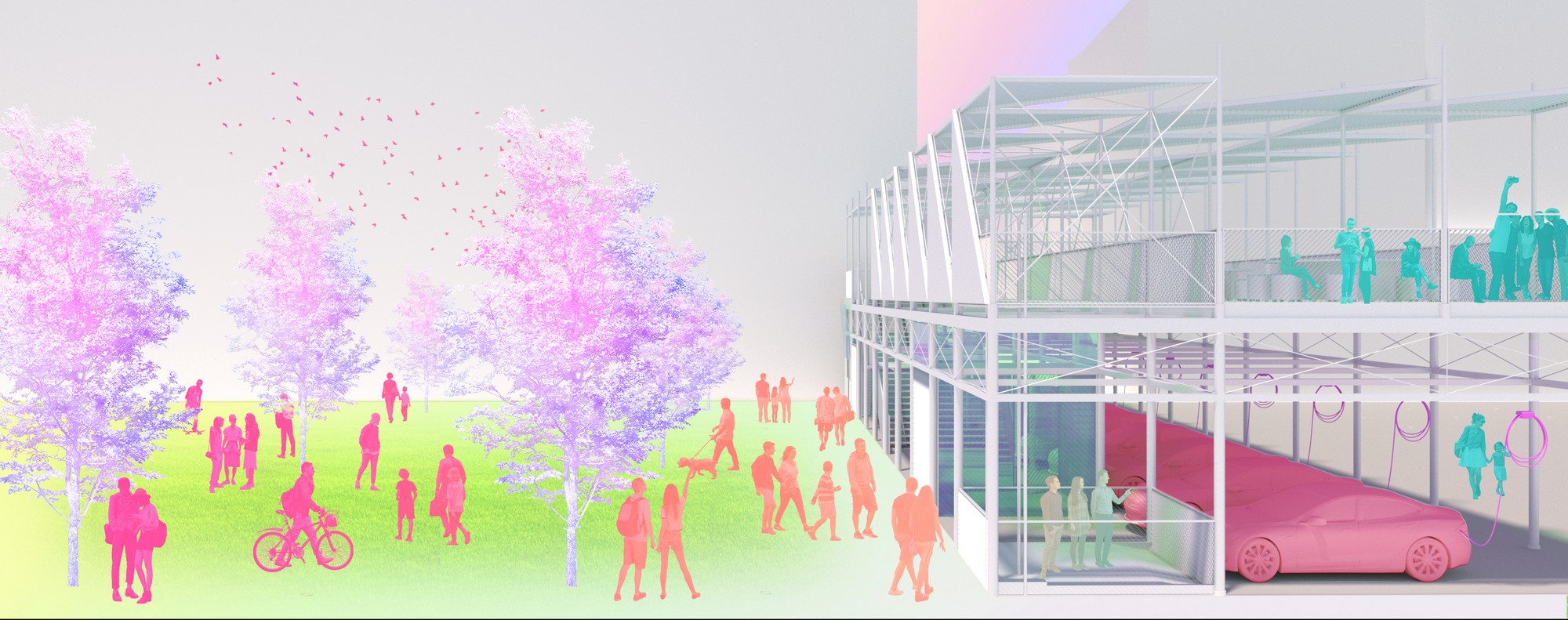





7 Comments
spa music
(October 27, 2023 - 6:13 pm)spa music
spa music
jazz music
(November 25, 2023 - 6:25 pm)jazz music
jazz music
Elegant Jazz
(November 26, 2023 - 10:15 pm)Elegant Jazz
Elegant Jazz
stress relief
(November 28, 2023 - 11:20 pm)stress relief
stress relief
relaxing sleep
(December 11, 2023 - 6:42 pm)relaxing sleep
relaxing sleep
water sounds
(December 29, 2023 - 2:10 am)water sounds
water sounds
beautiful piano music
(January 5, 2024 - 1:24 am)beautiful piano music
beautiful piano music
Comments are closed.